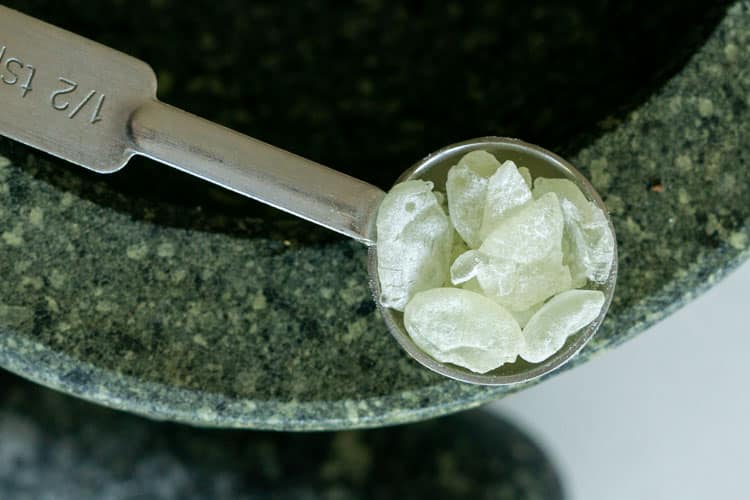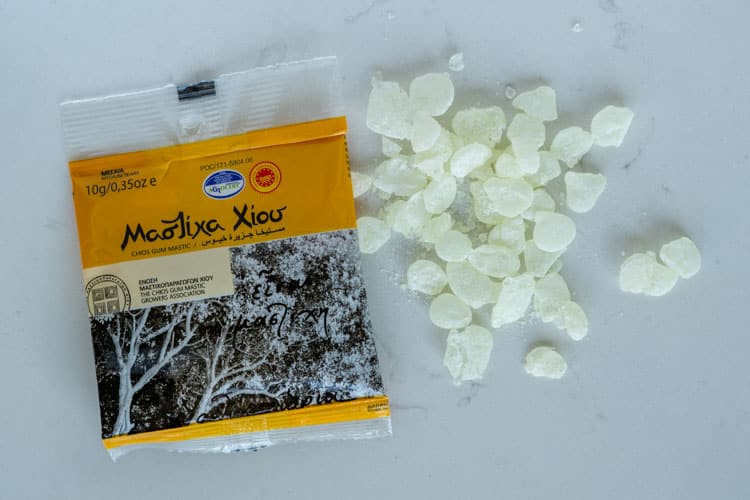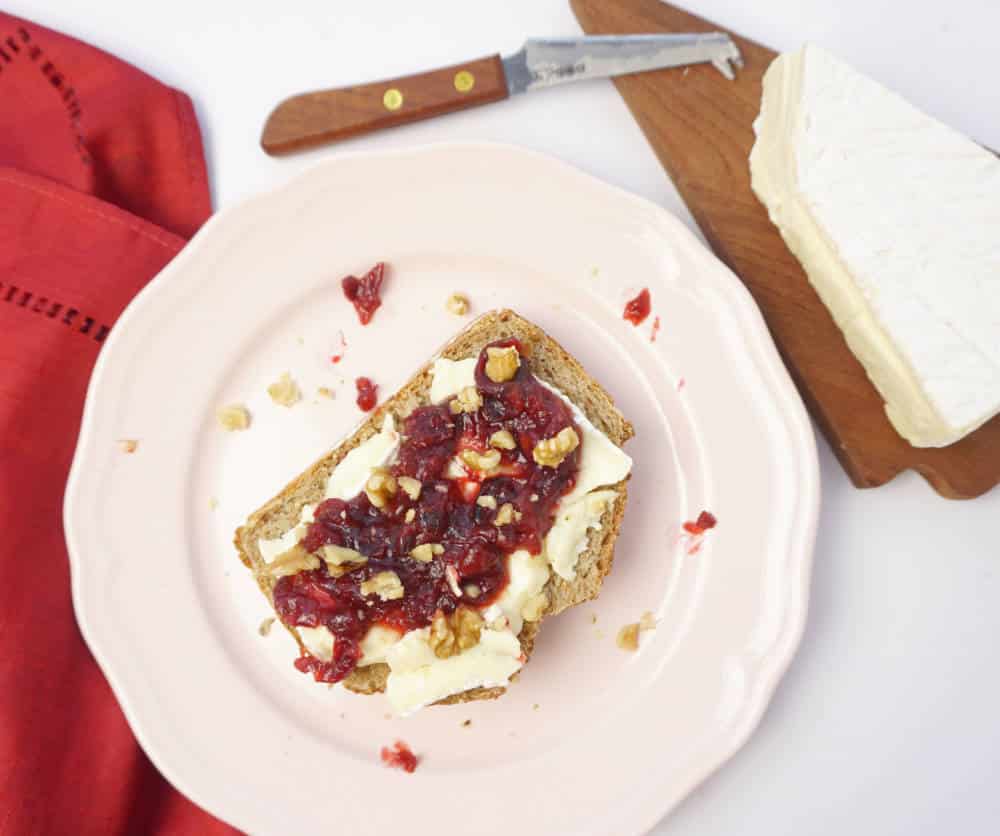Learn the science behind:

Mastic Flavor Science – Why Mastic Ice Cream Tastes Different Than Pure Mastic Gum
Always looking for something new to learn and investigate, we were intrigued by a recent question that was sent in by a FoodCrumbles reader. She enjoyed making and eating mastic ice cream, as did a friend who came over to visit. Curious about the flavor of mastic itself, they also tasted pure mastic (without the ice cream). However, they found it didn’t strongly taste like anything. Mixing it with a little cream (to simulate the ice cream) didn’t change it. However, once they mixed it with some sugar the mastic taste shone through. What was going on?
Up to this point, we had never used nor tasted pure mastic. So, we immediately placed an order for some at an online Greek food store and started digging and experimenting!
What is mastic?
While our order was on its way, we started doing some pre-work into the science of mastic. We quickly learned that mastic is a resin made by the tree Pistacia lentiscus L. var. chia. This specific tree only grows on the island of Chios in Greece, making it a very unique ingredient.
Resins on the other hand are very common. A lot of plants, mostly trees produce resins. Generally, these resins come out of the tree when it’s damaged or wounded. The resin protects the plant from insects and disease. Resins are generally very viscous, thick materials, that often turn solid once they’re out of the tree.
Mastic has been used by humans for its perceived health benefits for centuries, if not millennia. The protective properties of resins for plants seem to work for some health complications for humans as well in this case.
Mastic gum is harvested by making an incision in the bark of the tree. The resin will seep out and crystallize in solid form on the outside. It can then be collected by harvesters who can then make another cut to collect more mastic. One tree only makes up to 650g of mastic resin per year.
The crystallized mastic gum is then sorted by size through sieving, and is then ready for use!
Individual mastic gum pieces are quite hard. Upon chewing, you’ll find they soften into more of a gum consistency. Mastic gum has a smell that might remind you of pine trees. Some enjoy it, others are put off by it. It’s an acquired taste, probably one that is influenced by what you’ve eaten growing up (pretty much like Dutch licorice).

Mastic composition
The majority of mastic gum is made up of terpenes and terpenoids. Terpenes are a group of molecules made of carbon and hydrogen atoms with the formula (C5H8)n. Terpenoids are closely related, but also contain some oxygen atoms. Both are commonly found in resins and made by a lot of plants. They help give the resin its plant-protective properties. Terpenes are widely used as flavors in the food industry and terpenoids are instrumental in defining the flavor of a lot of different plant materials used in food. The characteristic hop flavor in beer comes from terpenes for instance.
Another very common terpene you’ve likely come across: natural rubber!
Essential Oils dictate flavor
About 1-3% of mastic gum is made up of essential oils. These oils are what give the mastic its characteristic pine-y smell and flavor. Essential oils are also common in foods, citrus peel, as well as a lot of spices and herbs, contain essential oils. Essential oils are always made up of a complex mixture of a lot of different components, however, generally, each oil contains a few flavor molecules that are instrumental for its characteristic flavor profile (as is the case for vanillin in vanilla).
Two of the most important flavor molecules in mastic gum oil are α-pinene & β-myrcene. Both are terpenes and aren’t unique to mastic and can be found in a lot of oils from other plants. As the name already suggests, pinene is a common compound in the oil of pine trees. But you can also find it in reasonable quantities in anise seeds, rosemary, and orange peel oils. Of the oil present in mastic gum, as much as 60-80% is made up of α-pinene, indicating it’s a high-quality oil. Myrcene, which is a monoterpene is commonly found in bay leaves, ginger, and black pepper, to name just a few. It makes up a smaller amount of mastic oil (7-20%) but is also important for determining the quality of the mastic.
The Gum
Whereas the oil is mostly made up of smaller terpenes, mastic gum as a whole contains a lot of triterpenes (C30H48), slightly larger molecules.
The ‘chewability’ of mastic gum is determined by the presence of polymers. Polymers are large molecules and due to their size, they have some unique properties. They can get entangled and form structures in ways that smaller molecules can’t. Interestingly, in some instances, the polymers in mastic gum can enhance structures (called a positive filler effect), which is the case when using it with egg white foams for instance (hence the use in nougats & meringues, see below). Whereas in other cases the effect might actually be negative. This all depends on the chemical interactions of the mastic polymers with the molecules of the material it’s incorporated into.
Other common examples of polymers in food are starches as well as gum such as xanthan gum.
Uses of mastic gum
Mastic gum can be used as is, as chewing gum. However, in most cases, you’ll add sugar and some other ingredients to create a slightly better texture and sensory experience, depending on your preferences.
Seeing as how mastic comes from a Greek island, most of its culinary uses are in eastern Mediterranean dishes. You will find it being used in ice creams, candies (e.g. Turkish delight), cakes, or even in meringues or nougats. Generally, only small quantities of mastic are used in these treats. Using too much will give them a piney, turpentine flavor and smell, due to the terpenes we mentioned above. Before use, mastic will be ground down into smaller particles before being incorporated into the product. Aside from flavor, the mastic can also impact the texture of the products!
For other applications, manufacturers might only use the essential oils of the mastic gum. They separate the oil through a process called steam distillation. The oil can then be used in (alcoholic) drinks, but also in perfumes or other cosmetics!

Using & Tasting mastic gum
Having done our pre-work, it was time to have a look at our own sample of mastic, which arrived in the mail a few days after ordering. We immediately recognized the drops and shapes from our earlier research. Once we opened the packed, we also noticed the slightly pine-y smell. However, upon taking a piece in our mouth and chewing it, we were a little disappointed by its flavor, it just wasn’t that strong at all. However, we remember out reader’s question, they had clearly experienced the same.
Ice cream does bring out the flavor!
So, we set out to work and made an ice cream using the mastic, using our egg less ice cream recipe as a base. Even though we only used a small amount of crushed mastic gum (1/2 tsp for 500g of ice cream) the flavor of the ice cream was a lot stronger than that of the pure mastic gum! Just as our reader had reported as well.
We experimented some more and noticed that eating the ice cream with a fresh, fruity, berry tart balanced out that piney flavor again (which we though was a good thing, the mastic taste was too strong in our ice cream in our opinion). A less sour orange cake on the other hand did not do as much for the flavor.
Flavor interactions of mastic
Unfortunately, we couldn’t find a proper explanation of our observations, nor could we find others who’d had the same experience (apart from our reader). However, by pulling together a few separate scientific pieces of insights, we think we might have a few explanations for what is going on here:
A bit like pairing wines
It is well known that different flavors can strengthen one another or cancel each other out. It’s what a good sommelier does every day. They pair wines with food in such a way that flavor notes of the wine that you wouldn’t have tasted otherwise are accentuated. Just exactly how these molecules interact with one another remains complicated (there’s simply too much going on). It’s clear though that what we perceive can be really different based on how things are paired together.

Food Pairing
Pairing spices and flavors isn’t just done and known for wines, it’s what you do every time you combine different spices and foods. The company food pairing has developed an extensive database of just which flavors pair well and which don’t. Part of the science involves just how some flavors can hide or highlight others. We’d expect something to be going on here for our mastic as well!
The sugar (and fat) interaction
Researchers have done work to investigate the impact of polymers, sugars and fats on flavor perception and whereas they haven’t done any work on mastic directly, they have done work on other flavors. Some polymers are great at hiding flavor. It’s likely that the polymers in mastic gum hide some of its own flavors, making the flavor of pure mastic gum quite mild.
Similarly, they found that in high sugar syrups certain flavors are brought out a lot more. Which are brought out more is a matter of chemistry. Sugars are polar molecules and as such will highlight polar flavors. The opposite is true for fats which are apolar and thus highlight the apolar fat-soluble flavors.
Without diving into the details, it’s likely that some of this is happening in our mastic ice cream. Mastic ice cream contains a considerable amount of sugars that highlight specific mastic flavor molecules!
References
Miquel Angelo Parente Ribeiro Cerqueira, Ricardo Nuno Correia Pereira, Oscar Leandro da Silva Ramos, Jose Antonio Couto Teixeira, Antonio Augusto Vicente, Edible food packaging, CRC Press, 2017, section 4.2.3.7, p. 131, link
FoodPairing, link, visited June-2021
Anilkumar G. Gaonkar, Andrew McPherson, Ingredient Interactions: Effects on Food Quality, CRC Press, 2016, chapter 14: flavor interactions in food, link
Kristberg Kristbergsson, Semih Otles, Functional properties of traditional foods, Springer, 2016, chapter 19, link
Yorgos Moussouris, Pedro Regato, Tapping the Green Market: Management and Certification of Non-timber Forest Products, Routledge, 2017, chapter 17, Mastic gum (Pistacia Lentiscus) (…) and chestnut (Castanea sativa), link
Gary A. Reineccius, Source book of flavor, Springer, 1994, table 3.2, link
Wikipedia, Resin, link, visited June-2021
Wikipedia, Terpenes, link, visited June-2021
What's your challenge?
Struggling with your food product or production process? Not sure where to start and what to do? Or are you struggling to find and maintain the right expertise and knowledge in your food business?
That's where I might be able to help. Fill out a quick form to request a 30 minute discovery call so we can discuss your challenges. By the end, you'll know if, and how I might be able to help.






